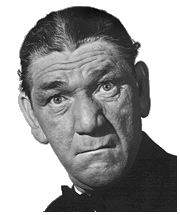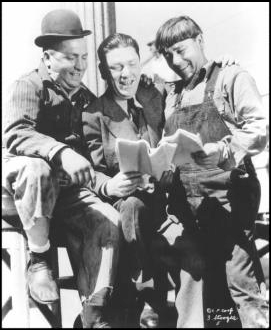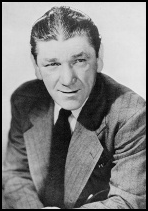Shemp Howard
The Man, The Myth, The Stooge
(March 17, 1895-November 23, 1955)
In Jewish culture, a boy becomes a man when he turns thirteen.
In Stooge culture, it happens when he learns to love Shemp.
A Stooge fans first instinct is to compare Shemp with Curly.
It was, after all, Shemp who replaced his younger brother after
Curly fell ill and retired from the group in 1947. To some Curly
lovers, this already made Shemp a bit of a badguy; no one, they
claimed, could replace their hero.
They were right. It would have been impossible for anyone...even
a comic actor as immensely talented as Shemp...to mimic the mesmerizing
movements and irresistibly childlike persona that made Curly legend.
To his credit, Shemp never tried. Instead, he relied on skills
that already had established him as a great slapstick actor: an
uncanny sense of timing, a savvy demeanor, and the apparent ability
to move in 100 different directions at once. To watch Shemp shadow-box
is to witness a mini-ballet in which an unfathomable whirlwind of
bobs and weaves and double-slaps culminates, inevitably, in Shemp's
own demise. Think that fancy footwork went unnoticed? Just tune
in the popular television program Sienfeld, where Michael
Richards's Kramer character pay homage every episode to all that
Shemp did first.
 Columbia
was reluctant to hire Shemp as Curly's replacement, fearing he looked
too much like his brother Moe (and perhaps not enough like brother
Curly). But their minds soon changed as movie theatre owners continued
to demand Stooge shorts to attract customers. Columbia
was reluctant to hire Shemp as Curly's replacement, fearing he looked
too much like his brother Moe (and perhaps not enough like brother
Curly). But their minds soon changed as movie theatre owners continued
to demand Stooge shorts to attract customers.
Shemp, in the meantime, was bringing a newfound worldliness to
the Stooges. He carried the air of a man who'd been around, a fellow
who could toast gorgeous dames with gilded pickup lines such as
"A couple of pip-pips, a little barbecue, and what have you!"
When Moe warned him to stop making goo-goo eyes at a knockout blonde
because the Stooges were in her home on business, Shemp informed
him coolly, "I mean business!"
He was as cunning with men as he was charming with women. A master
at controlling the crooked card tables of the Old West, he would
rake in whopping poker jackpots with trademark poise and a casual
"Come to Papa!" To colleagues who toasted him with a cheerful
"Here's how," Shemp always declared suavely, "I know
how!" Tough guys who insulted him were often told, "Them
is fightin' words in my country!" When the brutes agreed to
fight, however, Shemp used his wits instead of his fists, reminding
them, "Well, we're not in my country."
As a top-flight physical comedian, Shemp was naturally concerned
about his body. Nursing a bum leg, he told a physician not to amputate
because "I've had it ever since I was a little kid." This
concern for his own well-being often manifested itself in exaggerated
symptoms, as when Shemp reported that "six lions were tearing
me apart bit-by-bit" after a frog had slipped down his shirt.
Despite the Stooges' limited income, he tried to dress well, even
asking Moe if his slip was showing when they wore kilts as Scottish
detectives in Hot Scots.
 Shemp was born
Samuel Horowitz in Brooklyn. He was the third of five boys, two
years older than brother Moe and eight years brother Curly's senior.
His favorite Stooge film was his first, Fright Night (1947).
He married Gertrude Frank in 1925 and had one son, Mort, before
his death from a sudden heart attack in 1955 at age sixty. Shemp was born
Samuel Horowitz in Brooklyn. He was the third of five boys, two
years older than brother Moe and eight years brother Curly's senior.
His favorite Stooge film was his first, Fright Night (1947).
He married Gertrude Frank in 1925 and had one son, Mort, before
his death from a sudden heart attack in 1955 at age sixty.
From The Official Three
Stooges Encyclopedia by Robert Kurson
Back to Wall of Shemp |
